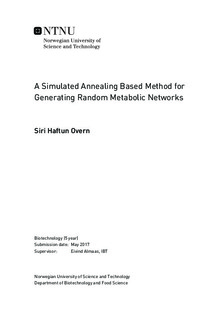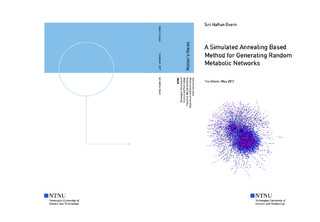| dc.description.abstract | A new method for randomization of metabolic networks was developed. The method was based on a Simulated Annealing algorithm, which is a well known technique for approximating optimal solutions to optimization problems. By modifying the original algorithm to include two temperature parameters instead of one, two different properties of the networks could be optimized at the same time. Compared to the original metabolic networks for microbes, previously generated random metabolic networks have had an extremely high fraction of blocked reactions. This was the motivation to develop a new method.
In this new method, both the total number of reactions and the fraction of blocked reactions in the networks were kept at their optimal levels. In addition to these requirements, the networks should also be viable, which means they should be able to produce biomass. Metabolic networks from three different microbes of varying sizes were chosen for randomization: Escherichia coli, Mycobacterium tuberculosis, and Helicobacter pylori. The content of these networks was randomized by replacing the metabolic reactions with new reactions from a reaction universe.
Extensive testing of the two temperature parameters established that the method was able to generate random networks with a lower number of blocked reactions while the total number of reactions remained stable. The disadvantage of this method is that it took a very long time to generate new random networks. Nevertheless, it is possible to save huge amounts of time by making some improvements in the algorithm. Suggestions for such improvements are given, but not implemented here.
Although the fraction of blocked reactions was lower than in the previous networks generated, the fraction of essential reactions was virtually unchanged. Visualization of the random networks pointed out that the majority of them had formed multiple clusters of reactions, which explained the unexpected high fraction of essential reactions.
The random metabolic networks were also tested for growth in different growth media. These results indicated that the random networks were only able to produce biomass in the growth medium they were generated in, and otherwise not. This supports that metabolic reactions and pathways that are not in use will be lost in the randomization process. | |

